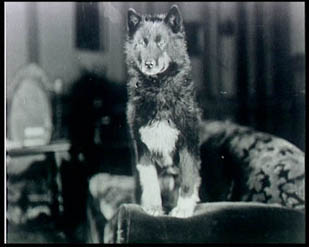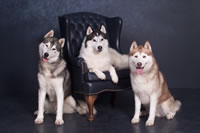
Harry Wheeler and his Siberians, Kree Vanka far right
Seppala Siberian Huskies

Harry Wheeler and his Siberians, Kree Vanka far right
Siberians are used for many purposes, pet, show, trekking, racing and more. One of the best known bloodlines for racing traces back to Leonard Seppala, and are reverently referred to as "Seppalas".
Leonard Seppala was one of the earliest kennels working with the dogs that were being imported directly from Siberia. In the early 1900's sled dog racing was becoming more popular and the "Little Siberian rats" ruled the races from the moment they first landed. At that time many people described them as being almost "foxy", or even "wolfy, but much smaller". They were usually 50 lbs or less, with thick warm fur, small prick ears, sickle tails, the innate desire to run, and the ability to pull moderate loads over long distances. These speedy dogs could cover a great deal of territory efficiently, with out tiring, and eating almost nothing. They were significantly faster than the heavy freight style crossbreds that were being used at that time. During the Diphtheria epidemic in Nome, Leonard, led by Togo and Scotty, ran the longest leg of the relay (the total distance covered being approximately 360 total miles including going out to the rondezvous point etc) that brought the serum to the stricken town. From all of the many dogs and teams that ran, one lead dog, Balto, took a superhero's place in the newspapers and entered into the history books. Balto of Seppala's true story is that he was a dog Leonard considered to be of lesser quality and the dog was sent to run for another musher Gunnar Kassen hauling freight for the mining company that employed the two men.. Balto ran lead for part of the last, and shortest leg (50 miles), through horrible weather, and into main street Nome. Kassen and Balto became heroes, but with the growth in popularity of dogsled racing Leonard Seppala's Siberian Huskies became world famous.
 |
Leonard Seppala's dog famed Balto, the
leader of the last team in the relay that brought the Diphtheria serum to Nome |
Kassen, Balto and the team toured the US for a few years, the team finally retiring on public display at a zoo. Leonard took his dogs and began racing in the lower states and with Togo he toured the US. Eventually Seppala finally returned to his Alaska and beloved dogs and continued on sledding and breeding the best racing huskies of their time. Eventually Leonard's dogs were found in many kennels, but it was in Harry Wheeler's "Of Seppala" kennels in St. Jovite Station, Quebec, that the line progressed in possibly it's purest form. The "Seppala" as a pure line was maintained in Canadian (primarily in "of Seppala", Markovo, and Seppineau kennels) though to the 1960's with a small pocket of dogs from Seppala also being located in Poland Springs (USA).

Leonard Seppala in a 1931 race
Many breeders today proudly trace their lines to Seppala bloodlines. It is very common to see "Sepp" as part of their kennel names. This claim to have pure, or even strong, "Seppala bloodlines" is not always truly accurate. In the 1990's a movement grew in Canada's Yukon to "locate and rescue" the pure Seppala bloodline from the remaining Canadian dogs. A registry for the "Seppala Sleddog Project" was developed to help identify and preserve the historic genome. Shortly there after another group in the USA approached the newly formed Continental Kennel Club to register the "Seppala Siberian Sleddog" as a breed separate from the Siberian Husky, and to allow the increase of the gene pool with an open registry.
The dogs of Leonard Seppalas kennel do not resemble most of the dogs referred
to as "Racing Seppalas" Today's races are run under very different
conditions where the largest weather problem is the heat, not the cold. Modern races are generally are run on groomed trails, with out loads,
using ultra light racing sled, at
much faster speeds. These modern racing "Seppalas" are generally
have much shorter and thinner coats which are more suited for dissipating heat
rather than keeping the dog warm. The modern speed racing Seppala is much
longer legged, finer boned, and have a narrower head and body type. They also
tend to have significantly larger ears and narrower chests. The saying
"Form Follows Function" is certainly at work with the changes in the style and conditions of
of races, and,
thusly, the changes in the phenotype of the "Seppala" Siberian Husky bloodline.
The wonderful array of colors and markings, now all but missing in the show
style Siberian, are still present in the modern Seppala, although the Irish
Pattern markings most pet people think of as "traditional" or
"typical" Siberian markings is
rapidly disappearing in the "Seppala Siberian", especially with the "Seppala
Siberian Sled Dog" due to the introduction of other breeds and crossbreds to the gene pool as allowed by the Continental Kennel Club registry and the ISSSD. If care is not taken with the breed to keep to the phenotype
of the bloodline established by Leonard Seppala and Harry Wheeler, the breed is in
imminent danger of becoming just another line of "Alaskan Huskies" or in other words, crossbred
speed racing dogs. Already much of the cold weather resistance is lost in many Seppala Siberians.
The modern Seppala racing sled dog is highly valued for its ability to speed race.
Touring, sprint, mid-distance, long-distance and recreational sledding are all
strongholds of the Seppala. Regardless of what fraction the observer, or owner,
is from, the ability and athleticism of these dynamic dogs is unmistakable.

Ember
Pedigrees of
Our Seppalas
|
|
Females |
Males |
|
|
|
Kalie Andi CeeMee, CeeYue |
Braveheart
Kevlar Khan Axxel Caber, Comet
|
|
Our
Seppalas are registered with the
Canadian Kennel Club
American Kennel Club
and Continental Kennel Clubs
About UsOur KennelsHommage to HawkeThe Seppala Siberian Husky |
Our BoysOur GirlsPuppies!
|
The Siberian HuskyMushing |

Contact us!
Shannon de Bruin BSc Ag
BEd
Lauren de Bruin BA
11524-37B Ave
Edmonton, Alberta
T6J 0K3
Our New Phone number is 780-584-2506
Shannondebruin@hotmail.com
Laurenworld@hotmail.com
Proudly
Shown in 6 Countries,
Shipping World Wide
We would love to hear from you!


The dogs of Balto's team were Billie, Tillie, Old Moctoc, Fox, Sye and Alaska Slim.